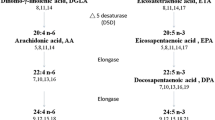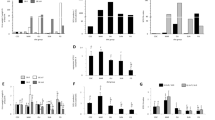Abstract
In this study, a new marine oil that contains 45% docosahexaenoic acid (DHA, 22∶6n−3) and 13% docosapentaenoic acid (DPA, 22∶5n−6) was administered to rats. The metabolism and distribution of DPA in rats was investigated. In experiment 1, the effects of DHA and n−6 fatty acids (linoleic acid, I A; arachidonic acid, AA; and DPA) on AA contents were investigated in vivo. LA group: LA 25%, DHA 30%; LA-DPA group: LA 15%, DPA 10%, DHA 35%; LA-AA-DPA group: LA 10%, AA 5%, DPA 10%, DHA 35% were administered to rats for 4 wk. In the liver, the AA content in the LA-DPA and LA-AA-DPA groups was significantly higher than in the LA group. The decreased AA contents in the LA group might be caused by DHA administration. Although DHA also was administered in the LA-DPA and LA-AA-DPA groups, the AA contents in these two groups did not decrease. These results suggested that DPA retroconverted to AA, blunting the decrease in AA content caused by DHA administration. To conduct a detailed investigation on DPA metabolism and its relation with AA and DHA, rat hepatocytes were cultured with pruified DPA and DHA for 24 h. We discovered the retroconversion of DPA to AA occurred only when AA content was decreased by a high DHA administration; it did not occur when AA content was maintained at a normal level.
Similar content being viewed by others
Abbreviations
- AA:
-
arachidonic acid
- BSA:
-
bovine serum albumin
- DHA:
-
docosahexaenoic acid
- DPA:
-
docosapentaenoic acid
- EFA:
-
essential fatty acid
- EPA:
-
eicosapentaenoic acid
- GLC:
-
gas-liquid chromatography
- LA:
-
linoleic acid
- PUFA:
-
polyunsaturated fatty acid
References
Nakahara, T., Yokochi, T., Higashihara, T., Tanaka, S., Yaguchi, T., and Honda, D. (1996) Production of Docosahexaenoic and Docosapentaenoic Acids by Schizochytrium sp. Isoalted from Yap Islands, J. Am. Oil Chem. Soc. 73, 1421–1426.
Nuringer, M., Conner, W.E., Petten, C.V., and Barstad, L. (1984) Dietary Omega-3 Fatty Acid Deficiency and Visual Loss in Infant Rhesus Monkeys, J. Clin. Invest. 73:272–276.
Bazan, N.G., Reddy, R.S., Bazan, H.E.P., and Birkle, D.L. (1986) Metabolism of Arachidonic and Docosahexaenoic Acids in the Retina, Prog. Lipid Res. 25:595–606.
Uauy, R.D., Birch, D.G., Tyson, J.E., and Hoffman, D.R. (1990) Effect of Dietary Omega-3 Fatty Acids on Retinal Function of Very-Low-Birth-Weight Neonates, Pediatr. Res. 28:485–492.
Sandra, N., Gharib, A., Croset, M., Moliere, P., and Lagarde, M. (1991) Fatty Acid Composition of the Rat Pineal Gland. Dietary Modifications, Biochim. Biophys. Acta 1081:75–78.
Bourre, G.M., Durand, G., Pascal, G., and Youyou, A. (1989) Brain Cell and Tissue Recovery in Rats Made Deficient in n−3 Fatty Acid by Alteration of Dietary Fat, J. Nutr. 119, 15–22.
Gunstone, F.D., Harwood, J.L., and Padley, F.B. (1994) The Lipid Handbook, pp. 173–175, Chapman & Hall, London.
Verdino, B., Blank, M.L., Privett, O.S., and Lundberg, W.O. (1964) Metabolism of 4,7,10,13,16-Docosapentaenoic Acid in the Essential Fatty Acid-Deficient Rat, J. Nutr. 83, 234–236.
Schlenk, H., Gellerman, J.L., and Sand, D.M. (1967) Retroconversion of Polyunsaturated Fatty Acids in vivo by Partial Degradation and Hydrogenation, Biochim. Biophys. Acta 137, 420–425.
Kunau, W.H. (1968) Uber dei Synthese der an allen doppelbindungen tritiummarkierten 4.7.10.13.16-docosapentaensaure und ihre Umwandlung in 5.8.11.14-eicosatetraensaure bei fettfrei ernahrten ratten, Z. Physiol. Chem. 349, 333–336.
Bridges, R.B., and Coniglio, J.G. (1970) The Metabolism of 4,7,10,13,16-[5-14C]Docosapentaenoic Acid in the Testis of the Rat, Biochim. Biophys. Acta 218, 29–35.
Homayoun, P.G., Durand, G., Pascal, G., and Bourre, J.M. (1988) Alteration of Fatty Acid Composition of Adult Rat Brain Capillaries and Choroid Plexus Induced by a Diet Deficient in n−3 Fatty Acids: Slow Recovery After Substitution with a Nondeficient Diet, J. Neurochem. 51, 45–48.
Guesnet, P., Pasval, G., and Durand, G. (1988) Effects of Dietary Alpha-Linolenic Acid Deficiency During Pregnancy and Lactation on Lipid Fatty Acid Composition of Liver and Serum in the Rat, Reprod. Nutr. Dev. 28, 275–292.
Sanjurio, P., Rodriguez-Alarcon, J., and Rodriguez-Soriano, J. (1988) Plasma Fatty Acid Composition During the First Week of Life Following Feeding with Human Milk or Formula, Acta Paediatr. Scand. 77, 202–209.
Carlson, S.E., Werkman, S.H., Peeples, J.M., Cooke, R.J., and Tolley, E.A. (1993) Arachidonic Acid Status Correlates with First Year Growth in Preterm Infants, Proc. Natl. Acad. Sci. USA 90, 1073–1077.
Cao, J.M., Blond, J.P., Juaneda, P., Durand, G., and Bezard, J. (1995) Effect of Low Levels of Dietary Fish Oils on Fatty Acid Desaturation and Tissue Fatty Acids in Obese and Lean Rats, Lipids 30, 825–832.
Suarez, A., Faus, M.J., and Gil, A. (1996) Dietary Long-Chain Polyunsaturated Fatty Acids Modify Heart, Kidney, and Lung Fatty Acid Composition in Weanling Rats, Lipids 31, 345–348.
American Institute of Nutrition (1977) Report of the American Institute of Nutrition ad hoc Committee on Standards for Nutritional Studies, J. Nutr. 107, 1340–1348.
Fujiyama-Fujiwara, Y., Ohmori, C., and Igarashi, O. (1989) Metabolism of γ-Linolenic Acid in Primary Cultures of Rat Hepatocytes and in HepG2 Cells, J. Nutr. Sci. Vitaminol. 35, 591–611.
Folch, J., Lees, M., and Sloane-Stanley, G.H. (1957) A Simple Method for the Isolation and Purification of Total Lipids from Animal Tissues, J. Biol. Chem. 266, 497–509.
Lowry, O.H., Rosebrough, N.J., Farr, A.L., and Randall, R.J. (1951) Protein Measurement with the Folin Phenol Reagent, J. Biol. Chem. 193, 265–275.
Author information
Authors and Affiliations
Corresponding author
About this article
Cite this article
Tam, P.S.Y., Umeda-Sawada, R., Yaguchi, T. et al. The metabolism and distribution of docosapentaenoic acid (n−6) in rats and rat hepatocytes. Lipids 35, 71–75 (2000). https://doi.org/10.1007/s11745-000-0496-z
Received:
Revised:
Accepted:
Issue Date:
DOI: https://doi.org/10.1007/s11745-000-0496-z




